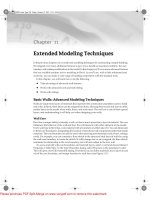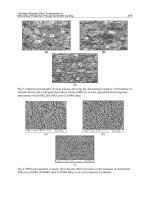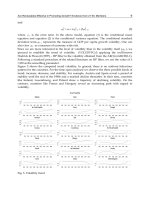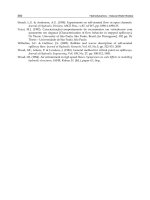Energy Management Systems 2012 Part 12 docx
Bạn đang xem bản rút gọn của tài liệu. Xem và tải ngay bản đầy đủ của tài liệu tại đây (1.55 MB, 20 trang )
Energy Management Systems
208
Departure and acceleration mode. The traction motors act as generators and while at a
station, the engine can be stopped For and necessary hotel power can be provided from the
battery. Upon departure, the train accelerates using the recovered energy only. Storage
battery operation of discharging mode.
8. Main requirements for hybrid traction system
The technical trends in train traction systems are shown in Fig.11, 12, 13. In line with those
trends, it is possible to develop rolling stock electrical-system with the following features to
meet the demand for reduced maintenance, energy savings, environmental friendliness, and
compact and light weight structures (Strekopytov, V. …, Electric drives…, 2003; Yamaguchi,
J. ,
Automotive Engineering, 2006).
Propulsion equipment requirements.
Hybrid traction system is used for high power variable voltage variable digital frequency
VVVF traction converter. The authors offer to implement the conventional converter-
inverter systems and auxiliary power converters which were applied vector control [5]
techniques and new semiconductor elements high-voltage IGBT (insulated gate bipolar
transistors) Commutation frequency of IGBT transistors is
f
k
>20000 Hz. (one element
parameters: 3300V, 1500A)
Traction motor speed control requirements. The authors suggest using AC traction motor
speed drive sensor less vector control methods. AC traction motor speed sensor less vector
control eliminating the speed sensor of traction motors creates space for increasing their
power and improving their maintenance.
All-speed range electric brake control. Hybrid traction system needs to use more accurate
traction motors speed estimation technology which enables the combination of sensor less
speed vector control (Liudvinavičius, Lionginas ,
The aspect of vector , 2009) with all-speed
range electric brake control.
Storage battery system. Storage battery system can be of different types, such as: C-with
capacitors; CB- conventional battery; C-CB- capacitors; CB- conventional battery.
Storage battery energy management system. Storage battery management technology
enables storing brake energy in diesel-powered trains, expanding regenerative brake energy
into high-speed region in electric trains, and stably supplying DC (direct current) power to
the auxiliary power converter. Using hybrid traction system electric train inverter control
technology makes regenerative braking possible and regenerated energy, temporarily stored
in the batteries, can be used as auxiliary power for acceleration. Fig.12. shows the Hybrid
Traction System auxiliary power inverter schematic circuit diagram.
The authors suggest using stored energy for starting the diesel engine. Fig 13 shows block
circuit diagram of the Hybrid Traction System equipment: the inverter control technology
enables using regenerated energy as auxiliary power for acceleration, i.e. the Figure shows
technical possibilities of using stored energy for starting the diesel engine.
Using this system, it is possible to start a 2000- 6000 kW diesel engine in a short time.
Traction motors regenerative braking energy charges ultra-capacitors block and latter ultra-
capacitors block energy is used for starting the diesel engine. The authors propose to use the
main inverter of Hybrid Traction System which operates on pulse- width modulation
(PWM) principle function.
Function principle of PWM inverter. The function of an inverter is to transpose the DC
voltage of the intermediate circuit into symmetric tree- phase voltage of variable frequency
Management of Locomotive Tractive Energy Resources
209
and amplitude. The necessary pulse diagram and the generated main voltage U
UV
(at the
terminals) are shown in Fig. 15. However, this voltage is non-sine-shaped. The effective
value of the assumed sine-shaped supply voltage must be proportional to the frequency by
changing the width of the single pulses in relation to the period duration. This kind of
voltage control is called pulse-width modulation (PWM)
Fig. 12. Principal circuit diagram of Hybrid Traction System auxiliary power inverter
Fig. 13. Block circuit diagram of the Hybrid Traction System diesel engine start operation
mode: DM- diesel engine; CB- conventional battery; K-contactor;
Fig 14 shows the example of a pulsed voltage block with five pulses per half-wave and the
resulting main voltage
U
UV
. In this process, the voltage pulses of the main voltage become
wider towards the middle of a half-wave as they first approach a sine-shaped course of the
main voltage. For this reason, this kind of drive is called sine-weighted pulse-width
modulation.
Energy Management Systems
210
Fig. 14. Pulse diagram for 5 pulses and inverter per main wave
Fig. 15. The main voltage
U
UV.
pulse resulting diagram of the principle generation of a sine-
weighted PWM
Fig. 15 shows the generation of pulse sequence for valve control and the resulting main
voltage U
UV .
Pulse frequency of the converter is determined by the frequency of delta
voltage. The higher the switching frequency is, the better the sine weighting of the converter
output voltage and the smaller the harmonic portion of the output currents are. A reduction
of the harmonic portion leads to smaller oscillating torque and losses of the motor. Thus, the
switching frequency should be as high as possible.
Management of Locomotive Tractive Energy Resources
211
The authors suggest using an externally supplied energy system with energy tender.
Fig. 16. Circuit diagram of hybrid energy traction system using energy tender vehicle
Fig. 17. Timing diagram of hybrid energy traction system using energy tender vehicle
Timing diagram is illustrating the locomotive energy management system, traction and
regenerative braking mode. Timing diagram illustrating the hybrid traction system has the
following energy storage possibilities:
0- t
1,
t
2
- t
3
-time cycles of using powered storage
energy traction and auxiliary equipment mode;
t
1
- t
2
time cycles of stored energy mode.
9. Energy saving and catenary voltage stabilization systems
Fig 18 presents the diagrams of voltage variation in direct current (DC) contact networks.
Their analysis shows that when the load current
I
C
increases in the complementary (DC)
contact network system, the voltage falls significantly (its value diminishes). In comparison
to standard voltage of 3000V in the contact network, the values are lesser by 10%, i.e. 300V,
whereas they are only -1% lesser in the complementary energy saving voltage stabilization
Energy Management Systems
212
system proposed by the authors. This is achieved by using energy storage batteries
parallelly connected to the direct catenary current (b). The batteries are charges from electric
trains during the regenerative braking of electric locomotives. Locomotives operating in the
traction mode use less electrical energy from traction substation I and substation II because a
part of energy is supplied by the energy storage batteries. These batteries do not require a
separate voltage source for charging as they are charged by using the kinetic energy of the
trains which emerges during the regenerative braking mode of electric trains and electric
locomotives. Conventional accumulators, a supercapacitors block or in parallel connected
accumulators and a block of supercapacitors may function as energy storage batteries. The
complementary system ensures the stabilization of catenary voltage (maintaining it in the
set boundaries) when the load current increases (from point A to point B) in the contact
network(Precision inductosyn position…, 1996).
Fig. 18. Parameters of energy saving and variation of catenary voltage in a conventional a)
and complementary energy management systems:
U
C
–catenary voltage; I
C
–catenary current
10. Structure and energy management in complementary energy saving and
current stabilization systems
Generally, first-generation electrified lines for railways, underground, trams and
trolleybuses were exclusively of direct current with voltages of 600, 750, 1500 and 3000V.
Although the catenary voltages 600, 750, 1500, 3000V are relatively low and do not meet the
present-day requirements since they limit the speed and weight of the trains due to the
voltage in the drop line. In order to increase the reliability and stability of DC contact
network (present energy system) and save some energy consumed for traction, the authors
suggest in parallel connecting energy storage batteries between the contact network and rail.
The principled scheme of energy saving and catenary current stabilization structure is given
Management of Locomotive Tractive Energy Resources
213
in Fig 19. Energy storage battery in parallel connected to the DC contact network is
composed of conventional batteries (CB) and supercapacitors block (SCB).
Fig. 19. Complementary principled scheme of energy saving and catenary current
stabilization structure: CB- conventional batteries; SCB-super capacitors block
Energy management system is presented in Fig 20. The authors propose using a
semiconductor key K, composed of IGBT transistors and diodes, for energy direction
control. In the traction-regenerative breaking modes, the energy direction and level of
battery charge may be controlled by sending control signals to the electronic key K.
Fig. 20. Scheme of energy management system structure:
I
R
– regenerative current; I
P—
traction mode current; K- semiconductor key for energy direction control
Energy Management Systems
214
The most challenging operating for storage devises on board of traction vehicle are high
number of load cycles during the vehicle lifetime, relatively short charge and discharge
times as well as high charge and discharge power values. The battery is charged when line
voltage goes up so that it limits the line voltage increase. Trains can unlimitedly generate
regenerative braking energy when capacitors SCB block and conventional storage batteries
CB operate. The regenerative braking energy is consumed by the train itself and by other
powering trains. Excessive power is stored in the battery. The charging voltage in the
batteries is higher than that of the substation. All charged energy is considered to come from
the regenerative braking. The SCB block and conventional store batteries CB enable limiting
the voltage increase during the charge. When powered trains are congested at rush hours
due to the line voltage tendency to drop, the batteries discharge to reach a voltage balance
between the voltages of the SCB-CB block and the substation. The new technical solution is
used in conventional batteries with high-performance double layer capacitors (ultra-
capacitors). Energy saving system can be used when the vehicles are provided with energy
source that allows frequent starting and braking. The system works by charging up these
storage devices with electrical energy released when braking. Energy savings and power
supply optimization system can reduce the energy consumption of a light rail or metro
system by up to 30 percent. Using power supply optimization system for diesel multiple
units enables to save more than 35 percent of energy. Alternatively, the stored energy can be
used as a performance booster, i.e. to enhance the performance of a vehicle by adding extra
power during acceleration.
11. Vehicle catenary – free operation possibilities
In addition to these well-known factors, the municipal authorities are increasingly facing
visual pollution caused by power poles and overhead lines obstructing the visibility of
landmark buildings and squares. With catenary-free operation, trams can run even
through heritage-protected areas, such as parks and gardens, historic market and
cathedral squares, where conventional catenary systems are not permitted, thus
preserving natural and historic environments. Authors suggest using catenary-free system
for trams, light rail vehicles and trolleybuses. In many city centers, the overhead lines and
their surrounding infrastructure contribute to visual pollution of historic streets, parks or
architectural landmarks. The new system allows catenary-free operation of trams over
distances of varying lengths and in all surroundings as well as on underground lines —
just like any conventional system with overhead lines. Catenary-free system traction
inverter is connected to the storage battery which is charged during vehicle traction motor
operation in regenerative braking mode and discharged during traction motor operation
in traction mode, where conventional energy lines are discontinued. Energy saver, which
stores electrical energy is gained during operation and braking on board of the vehicle by
using high-performance double layer capacitor technology. When running on
conventional system, trams and light rail vehicles take energy from an overhead electrical
line. The authors suggest installing the vehicle (inside or outside) with a storage battery
(ultra-capacitors block) which stores the energy gained during regenerative braking
operation and is constantly charged up, either when the vehicle is in motion or waiting at
a stop, picking up the power from the storage battery. Fig.21 22, 23, show vehicle
configuration and catenary-free operation possibilities. The power necessary for catenary-
free operation is provided from the battery.
Management of Locomotive Tractive Energy Resources
215
Fig. 21. Circuit diagram of vehicle catenary free operation: SB- storage battery
Fig. 22. Catenary-free operation of the vehicle: Y1-Y4-energy management drive signals; M-
traction motor
Fig. 23. Circuit diagram of catenary-free operation of the vehicle (traction mode)
The innovative double layer ultra-capacitors store the energy released each time a vehicle
brakes and reduce it during acceleration or operation. New technical solution is based on
double layer capacitors with along service life and ten times higher performance than
conventional batteries. High-performance storage cells are connected in series to create a
Energy Management Systems
216
storage unit. They store the electrical brake energy with relatively low losses(Fuest, K.;
Döring, P. Elektrische Maschine und Antriebe, 2000; Stölting, H D., Elektronisch betriebene
Kleinmaschine, 2002).
12. Hybrid locomotive energy balance
Within the bounds of the present research, the question of qualitative evaluation of
regenerative power during hybrid vehicle braking is of fundamental importance.
Vehicle power during braking on horizontal road
P
br
can be expressed by the following
equation:
br m
PkmaV
, (7)
Where:
k
m
- coefficient of rotational masses; m – vehicle mass; a – vehicle acceleration
(deceleration);
V- vehicle velocity. The power that can be received during regenerative
braking is:
re
g
en m re
g
en
PkmaV
, (8)
Where:
k
m
- coefficient of rotational masses; m - vehicle mass; a – vehicle acceleration
(deceleration);
V- vehicle velocity; η
re
g
en
- efficiency of regenerative braking (can be defined
as rate of energy, received during braking up to decrease the kinetic energy of the vehicle).
At the same time, regenerative braking power can be considered as electric power which is
finally received by the storage element (in this case storage battery):
re
g
en el bat bat
PPIU
, (9)
Were:
P
el
- electric power received by the battery; I
bat
- battery current; U
bat
- battery
voltage. The effectiveness of regenerative braking can be estimated using these equations:
regen
bat bat
regen
br m
P
IU
PkmaV
, (10)
JSC Lithuanian Railways has acquired four new-generation double-deck electric trains type
EJ-575. In order to evaluate consumption of energy of the new generation double-deck
electric trains type EJ-575, the authors carried out the practical research. The aim of the
research is to determine why the electric trains type ER-9M (without energy saving system)
and EJ-575 (with energy saving system), running in the same section, consume different
amounts of electrical energy. Practical research, and statistical comparisons of results are
carried out.
13. Practical researches of train EJ-575 energy management
In order to determine the double-deck electric train EJ-575 energy-management principles
and to measure the dynamic electrical and mechanical parameters, the practical experiments
were performed. The following channels of parameters measurement are predicted for
determining the quantity of energy for traction and electrodynamic braking: the primary
traction transformer winding of instantaneous current I
Tr
, the primary traction transformer
Management of Locomotive Tractive Energy Resources
217
winding of instantaneous voltage
U
Tr
, four-quadrant 4Q1, 4Q2 converters, flattening voltage
U
d,
the first and the second asynchronous traction motor – speeds of wheelsets (Braess, H.
H.; Seiffert, U., Vieweg Handbuch Kraftfahrzeugtechnik, 2000).
During practical researches dynamic parameters of energy management are measured by
using a personal computer, therefore the authors provide 5 converters of the
abovementioned channels analog signals conversion into discrete in the framework of
measurement: instantaneous current I
Tr
, instantaneous voltage U
Tr,
four-quadrant 4Q1, 4Q2
converters of flattening voltage U
d
, the first asynchronous traction motor – speed of
wheelset n
1
, the second asynchronous traction motor – speed of wheelset n
2
. The scheme of
the train EJ-575 traction-electrodynamical braking parameters practical research, using a
personal computer is given in Fig. 24.
J – high-speed disconnector; P – phantograph; 4Q1, 4Q2 – four-quadrant converters; I
1
, I
2
– inverters;
M1, M2 – AC asynchronous traction motor; C – energy accumulation condenser; X1, X2 – secondary
traction transformer windings current sensors; ST – primary winding traction transformer current
sensor; A1, A2 – secondary traction transformer windings; A3 – secondary traction transformer winding
for measurement of contact network voltage (25 kV); BU – flattening voltage sensor; R
b
– dynamic
braking resistor; VS1 – IGBT-transistor braking current (braking force) value regulator; BR1, BR2 –
speed sensors of traction motors; VD1, VD2 –diodes; C – capacitor; 1, 2, 3, 4, 5 – analogical-digital
converters; n
1
, n
2
– asynchronous traction motors speed variation; WS1, WS2 – wheelsets
Fig. 24. The scheme of the train EJ-575 traction-electrodynamical braking parameters
practical research, using a personal computer:
EJ-575 energy-management parameters are determinated on the 6
th
of October 2010 for the
train No EJ-818 of Vilnius–Kaunas district in traction-electrodynamic braking modes. The
measured dynamic parameters are displayed on monitor of personal computer. For the
convenience of the research results analysis the controlled parameters are provided in one
system of coordinates.
I
Tr
variation of current is provided in real values, the parameters of
instantaneous contact network voltage
U
Tr
, displayed on monitor of personal computer,
Energy Management Systems
218
must be multiplied by 100, flattening voltage U
d
values must be multiplied by 10; single-
carriage asynchronous traction motor of the train EJ-575 (of 1, 2 wheelsets) variation of
speed is charted by marking n
1
, n
2
, and shows the instantaneous values of train speed,
km/h. The values of dynamic parameters, measured with personal computer during the
practical research are given in Fig. 25.
I
Tr
– diagram of primary traction transformer winding current variation (A); U
Tr
– diagram of contact
network voltage variation(V); flattening voltage U
d
variation diagram (V); V – diagram of speed
variation of the train (km/h); t – time (s)
Fig. 25. Parameters values of the double-deck electric train EJ-575 energy-management in
traction-electrodynamic braking modes:
14. Results of practical research on energy control in EJ-575
Variation range of instantaneous active power P used in traction cycles 1T and 2T is up to
21250 kW (two separate windings of traction transformers). Variation range of
instantaneous active power
P in electrodynamic braking cycles 1S–2S is 25–60 kW. During
electrodynamic braking, the amount of energy is used only for power supply to ancillary
devices. The electrodynamic braking of the train is carried out using kinetic energy.
In traction and electrodynamic braking cycles, the amount of consumed contact network
energy
P(t) converted into useful work is described by the respective areas delineated by
curves. The amount of energy is determined by integrating the respective cycles, following
the given formulas (Bureika 2008; Dailydka,
Lingaitis … 2008):
t
PdtW
0
; (11)
Management of Locomotive Tractive Energy Resources
219
i
tt
tt
PdtPdtPdtPdtW
0000
3
21
. (12)
The diagrams showing variation of contact network energy
P(t) and electrodynamic braking
P(t) energy consumed in electric double-deck train EJ-575 are given in Fig. 26.
0–t
1
– traction cycle 1T; t
1
–t
2
– electrodynamic braking cycle 1S; t
2
–t
3
– traction cycle 2T; t
3
–t
4
–
electrodynamic braking cycle
Fig. 26. Diagrams showing variation of contact network energy P(t) and electrodynamic
braking P(t) energy consumed in electric double-deck train EJ-575:
Variation range of contact network energy
P
T
(t) consumed in traction cycles 1T and 2T is
represented in traction cycles 0–
t
1
and t
2
–t
3
; Variation range of electrodynamic braking P
B
(t)
energy is given in cycles t
1
–t
2
and
t
3
–t
4
. The amount of electrodynamic braking P
B
(t) energy
converted into useful work is described by the respective areas delineated by curves in
cycles
t
1
–t
2
and
t
3
–t
4
.
15. Results of research
Comparison of research results on electrical energy consumption in electric trains ER-9M
and EJ-575 in 2010 is presented in the diagrams below (Fig. 27, Fig. 28). They are given
following the statistical data of JSC
Lithuanian Railways.
Fig. 27. Electrical energy input (kW/10000 tkm) of electric trains ER-9M with DC traction
motors and EJ-575 with AC traction motors in 2010
Energy Management Systems
220
Fig. 28. Electrical energy input (kW/km ) of electric trains ER-9M with DC traction motors
and EJ-575 with AC traction motors in 2010
16. Conclusions
1. Electrodynamic braking is the main braking technique used for modern electrically-
driven locomotives.
2. The use of supercondensers in the locomotives with electric drive expands the
regenerative braking range to full stopping. This creates the conditions for full use of
kinetic energy of the train.
3. Using supercondensers enables replacing the diesel motors of powerful locomotives
and ships.
4. Supercapacitors were chosen to act as energy buffer.
5. The use of regenerative braking of electric locomotives for high-speed trains under the
conditions of heavy railway traffic allows 25–40 % of electric power to be returned to
the power system. The required regenerative braking forces can be obtained in a wide
range, with a possibility to return energy to energy supply in a high-speed range and to
store energy in a low-speed range.
6. All diesel electric powered locomotives should use hybrid traction technology.
7. Hybrid traction technology locomotives can use regenerative braking of high-speed and
a low-speed range.
8. The energy used by hybrid traction technology locomotives is reduced by 25–30 %.
9. The offered regulation algorithm allows obtaining various types of flat characteristics
enabling asynchronous traction motor to be extensively used in traction, recuperation
and dynamic braking modes of operation.
10. A circuit scheme of using hybrid traction technology with energy storage tender and
catenary-free operation was proposed.
11. It is possible to use the regenerative braking power in diesel electric locomotives for
starting engine, acceleration, and operation mode.
12. Energy savings and power supply optimization possibilities were proposed.
13. The electrodynamic braking system installed in EJ-575 enables to stop the train without
friction braking.
14. The electrodynamic braking system installed in EJ-575 enables a complete use of kinetic
energy of the train in the braking cycles without contact energy network.
15. The use of kinetic energy of the train saves 25–30 % of electrical energy used for
traction.
Management of Locomotive Tractive Energy Resources
221
16. Flattening voltage U
d
in ER-9M is step-controlled and for this reason, the currents of DC
traction motors and energy losses during starting are great.
17. Due to the step-controlled flattening voltage U
d
of traction motors in ER-9M, braking
alternates in a step manner, i.e. unevenly; thus the passengers experience discomfort
and automatic coupling is affected by dynamic forces.
18. Kinetic energy of the train is not used for braking in ER-9M. The train is braked using
friction, which increases operational expenses.
19. The speed of asynchronous traction motors of EJ-575 is evenly controlled by alternating
power supply voltage and values of frequency.
17. References
P. Barrade, Series connexion of Supercapacitors : comparative study of solutions for the active
equalization of the voltage
, École de Technologie Supérieure (ETS), Montréal, Canada,
2001
J. D. Boyes and H. H. Clark, Technologies for energy storage flywheels and super conducting
magnetic energy storage
, IEEE, 2000.
Braess, H. H.; Seiffert, U. Vieweg Handbuch Kraftfahrzeugtechnik. Friedrich Vieweg & Sohn
Verlagsgesellschaft GmbH, Wiesbaden. 2000.
Fuest, K.; Döring, P. Elektrische Maschine und Antriebe. Lehr- und Arbeitsbuch. Vieweg.
Wiesbaden. 2000.
R. G. V. Hermann,
High performance double-layer capacitor for power electronic applications, in
Second Boostcap meeting, Montena Components SA, Fribourg, Switzerland, 2001.
Liudvinavičius L. Lingaitis L. P. 2010.
New locomotive energy management systems. /
Maintenance and reliability = Eksploatacja i niezawodność / Polish Academy of
Sciences Branch in Lublin. Warszawa. ISSN 1507-2711. No 1, 2010, p. 35-41.
Liudvinavičius, Lionginas; Lingaitis, Leonas Povilas; Dailydka, Stasys; Jastremskas,
Virgilijus.
The aspect of vector control using the asynchronous traction motor in
locomotives.
, Transport. Vilnius: Technika. ISSN 1648-4142. Vol. 24, No 4, 2009, p.
318-324.
Liudvinavičius L. Lingaitis L.P: Electrodynamic braking in high-speed rail transport., Transport,
Vol XXII, No 3, 2007, p.p.178-186.
Lingaitis L. P., Liudvinavičius L.:
Electric drives of traction rolling stocks with AC motors.
Transport, Vol XXI, No 3, 2006, p.p. 223
229.
Precision inductosyn position transducers for industrial automation, aerospace and military
application. Farrand Controls information Issue. USA. 1996. 15 p.
A. Rufer and P. Philippe,
A supercapacitor-based energy storage system for elevators with soft
commutated interface
, IEEE Transactions on industry applications, vol. 38, no. 5, pp.
1151-1159, 2002.
Sen P. C. Principles of Electric Machines and Power Electronics. New York-Chichester-
Brisbane-Toronto-Singapore-Weinheim. John Wiley&Sons. 1996.
Strekopytov, V. V., Grishchenko , A. В.; Kruchek V. A. Electric drives of the locomotives.
Moscow: Marshrut.2003. 305 p.
Stölting, H D. Elektronisch betriebene Kleinmaschine. Vorlesungsmanuskript. Universität
Hannover. 2002.
Takashi Kaneko.,et al.,.
Easy Maintenance and Environmentally-friendly Train Traction System
Hitachi Review,Vol.53, No 1,2004
, p.p 17-19p.
Energy Management Systems
222
Yamaguchi, J. Blue skies at Makuhari. Automotive Engineering International, 2006, No 1,
p.55-62.
11
An Adaptive Energy Management System Using
Heterogeneous Sensor/Actuator Networks
Hiroshi Mineno
1
, Keiichi Abe
2
and Tadanori Mizuno
2
1
Faculty of Informatics, Shizuoka University
2
Graduate School of Science and Technology, Shizuoka University
Japan
1. Introduction
Global energy consumption has been increasing over the past half century, mainly due to
increasing populations and economic development around the world. Although the
development of low-consumption appliances, highly efficient heat pump systems (such as
Ecocute), and smart meters that identify consumption in more detail than conventional
meters contribute in no small part to reducing the emission of greenhouse gases in homes
and office buildings, it is important to understand that the rapid growth in ubiquitous
comfort services is resulting in higher power consumption. In the future, there may be
more convenient appliances coming on the market to create a ubiquitous smart
infrastructure.
Even though individual appliances might be ultra-low power, the amount of energy
consumption in buildings will increase as the number of these appliances increases. There
has been research in the field of home/building energy management systems
(HEMS/BEMS) (Cao et al., 2006; Inoue et al., 2003; Kushiro et al., 2003; Zhao et al., 2010), but
integrating new devices on the market is not easy. Moreover, it is difficult to develop
appropriate systems for different lifestyles. For example, a building's carbon footprint is the
product of complex interplay between the buildings' structural and infrastructure
characteristics, operational patterns and business processes, weather and climate dynamics,
energy sources, and workforce commute patterns. Because these disparate factors can
change daily, any recommendation based on a snapshot will rapidly become invalid.
Therefore, we believe the key feature of next-generation HEMS/BEMS is adaptability. If the
systems are able to use information from multi-vendor sensors/actuators in heterogeneous
networks, we can develop more adaptable energy management systems for visualizing and
controlling the living climate appropriately. We feel this would enable us to create
ubiquitous services for a more convenient, eco-friendly lifestyle.
We have developed an adaptive energy management system (A-EMS) for controlling energy
consumption by converging heterogeneous networks (Mineno et al., 2010) such as power
line communications (PLC), Wi-Fi networks, ZigBee, and future sensor networks. We
created a prototype system that enables users to freely configure a cooperative network of
sensors and home appliances from a mobile device. Although there are many similar
technologies for integrating multi-vendor devices (IEEE 1451; Sensor Model Language;
Device Kit; Chen, et al., 2009), we used P2P Universal Computing Consortium (PUCC)
Energy Management Systems
224
technology, which enables sensors and other devices to connect to each other. PUCC has the
advantage of detecting services and devices using a P2P network. We developed our
middleware with Java, which can work as a bundle on an Open Services Gateway initiative
(OSGi) framework (OSGi Alliance). Experimental results demonstrated that the proposed
system can easily detect wasted electrical energy that has never been noticed before.
The rest of this chapter is organized as follows. Section 2 outlines heterogeneous network
convergence as related work. In Section 3, we describe the features of our proposed A-EMS
in detail. Section 4 discusses the implementation of our prototype and section 5 shows the
experimental results. Section 6 concludes the paper with a brief summary and mentions
future work.
2. Related work
There are currently many electrical devices connected to networks. However, many types of
networks coexist, and they all use different communication protocols. Therefore, a
technology to integrate different networks is needed to provide services and control various
devices connected to different networks. In the same vein, sensor/actuator devices also have
a networking function and can be used to construct a smart system (Tzeng et al., 2008; Han
et al., 2010; Park et al., 2007; Son et al., 2010; Suh et al., 2008). However, most services for and
studies on sensor networks are limited to a particular sensor network. If it were possible for
sensors/actuators to communicate with several types of networks, various devices could
use heterogeneous sensor data.
Because the Internet Protocol (IP) horizontally integrates the control mechanism between
heterogeneous networks and their extensions, heterogeneous network convergence would
provide a tremendous opportunity for future advanced infrastructure management. The
trend with sensor/actuator networks is the same. Recent developments with small sensor
nodes that can be connected to a network have spurred studies on integrating non-IP-based
sensor networks, which function by connecting several nodes, in which IP-based sensor
gateways are being developed as common interfaces for connecting devices.
To create IP-based sensor gateways, we can use a number of proposed standards to describe
devices and enable their integration (Chen et al., 2008). For example, IEEE 1451 describes a
set of open, common, network-independent communication interfaces for connecting
devices to microprocessors, instrumentation systems, and control/field networks. SensorML
focuses on creating measurement models using sensors and instructions for deriving more
accurate information from observations. Device Kit, following SODA (Chen, et al., 2009), is
an OSGi-enabled technology that can interface with hardware devices using Java. It enables
the development of applications for devices when hardware-specific information is
unknown. Although these standards model devices all have various advantages, we used
PUCC specifications because they enable sensors and all other devices to connect to each
other. PUCC has the advantage of detecting services and devices through a P2P network
such as an UPnP network.
3. Adaptive energy management system (A-EMS)
3.1 Installation level
Although there has been previous research on HEMS/BEMS, it has been limited to “detect
something and notify or control predefined action.” These systems are not versatile.
An Adaptive Energy Management System Using Heterogeneous Sensor/Actuator Networks
225
Actuator networks
Sensor networks
Attemperation
Brightness
control
Client devices
Motion
detection
Smart power
strip
Gateway
ManagementPrediction
Tu rn on /of f
Visualize
Sensor cloud
(Distributed file system)
Control
Viewer/
controller
Data mining
Level 1: illuminance, temperature, humidity, motion
Level 2: + smart power strip
Level 3: + smart power switch
Level 4: + infrared remote control
Level 5: + healthcare sensor (body temperature, heartbeat, weight)
Level 6 : + weather sensor, micro-grid (solar, heat, gas, fuel cell)
Control
Coexist
Visualize
Fig. 1. Overview of proposed adaptive energy management system (A-EMS) and its
implementation levels.
Moreover, it is not easy to integrate a vendor's new device after deployment, and it is
difficult to develop appropriate systems for users with different lifestyles. Fig. 1 shows an
overview of our proposed A-EMS and its implementation levels. We designed the A-EMS
on the basis of a sensor cloud as a feedback system. In the proposed system, a PUCC P2P
network is established among IP-enabled nodes. If the sensor gateway of another domain
network acts as the PUCC P2P node, the PUCC P2P network incorporates the
heterogeneous network and allows P2P nodes and sensor gateways to access the connected
network adaptively.
The system can be installed in a phased manner depending on the required energy
management level and available sensor/actuator devices. Level 1 visualizes the living
climate. We can visualize the transition of unknown information, such as living climate data
and someone's presence or absence, by installing different types of sensor nodes that sense
illuminance, temperature, humidity, and motion. Level 2 visualizes the energy
consumption. We can determine the effect of energy-saving actions by revealing the
correlation between life pattern and energy consumption via additionally installed smart
power strips instead of existing power strips. In this work, we assume the smart power strip
is an electrical meter that can remotely report the power consumption in addition to power
factor, electrical current, and pressure of connected devices. Level 3 controls the legacy
Energy Management Systems
226
appliances. If the smart power strip can turn on/off the connected devices remotely, we can
execute basic living climate control for energy saving, such as turning off the standby power
of appliances. Level 4 controls the appliances that have an infrared remote (IR) control
function. There are many devices in homes that have this function, so we can include multi-
vendor devices as controlled objects if such an actuator node is installed in our system.
Level 5 achieves coexisting. If healthcare sensors, such as body temperature, heartbeat, or
weight, are installed in the system, it can execute personal living climate control based on
different comfort levels and conditions. Then, at level 6, the living climate control is
consciously aware of the balance between natural and artificial control because it takes
advantage of information on heterogeneous networks as well as information from the
weather sensor and micro-grid (solar, heat, gas, and fuel cell).
3.2 PUCC overlay sensors/actuator network
The PUCC is a standard-setting organization that develops technologies to connect and
operate many types of devices on P2P overlay networks. By forming an overlay network
using PUCC protocols, we can seamlessly connect devices in a heterogeneous network
environment. PUCC protocols are defined on an application layer as an upper-level protocol
of existing communication protocols like TCP/IP and ZigBee.
The PUCC platform provides these protocols as general-purpose middleware independent
of any specific application. Various P2P protocols necessary for P2P communication can be
implemented in this platform. A middleware application programming interface (API)
enables access to P2P protocols. By installing PUCC middleware on every device or gateway
that communicates with other devices, various functions are provided in addition to P2P
communication (Kato at el., 2009). We developed a library for communication using PUCC
protocols that provides the API which device can participate in the PUCC network and uses
methods to enable cooperative behavior with other devices. Methods that are central to our
system include the discovery, subscribe, notify, and invoke methods.
The discovery method enables us to obtain information about a device in the network. This
information is described in a PUCC format. The subscribe method enables us to know of
changes in devices states. The device monitors its own status, and if it changes, it announces
the change by using the notify method. The invoke method enables us to execute services
involving a device: e.g., turning on an appliance.
The PUCC P2P and gateway nodes have metadata to describe information on published
services (Fig. 2). If the gateway node has several devices/nodes connected to another
domain network, the gateway might describe several services as either one or several sets of
metadata. A metadata sample is shown in Fig. 3.
3.3 Mutually complementary communication
We proposed the use of a mutually complementary communication protocol (MCCP) for
indoor sensor/actuator networks based on multi-interface communications (Sawada et al.,
2011). The MCCP uses several metrics of link quality indicator (LQI) in each interface to
cognize the state of the path and tracks the variation of the network topology for
transmitting data. Each node periodically informs the LQI values of each interface, each
node is able to select the better interface for transmitting data to the neighbor nodes. The
protocol basically follows the link state routing protocol which is well used in the computer
communication network.









